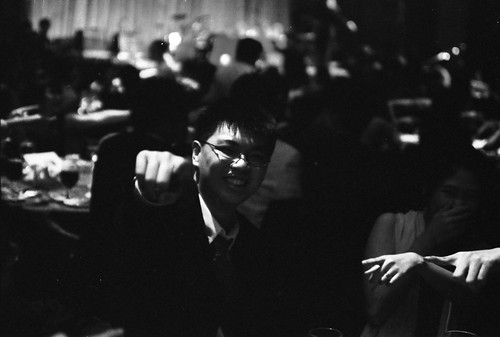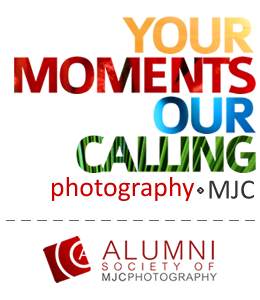Today I'm going to talk about knowing the limitations of your equipment. After you get your DSLR, knowing how to shoot for an event and protect your camera equipment is not enough...
Just today I was on Clubsnap reading about some ridiculous suggestions some people gave to a 16 year old boy who was going to cover his school's Prom Nite, to which he has no idea how due to the dim lighting of the event, and he was only equipped with a 450D, kit lens, 50mm, 55-250mm.
Somebody suggested that he rent a 24-70mm f2.8 lens, which would cost about 30 dollars a day.
I guess when you kids shoot for event, there is nothing much you can really choose from especially when there are so many of you and just that number of available lenses. In my time, there was hardly choice- just the 15-30mm, 70-200mm and the so-called tamron kit lens.
So you might me thinking... WAH, go shoot event at hall ah, I only got kit lens leh... HOW?!
Don't worry for the Grouch is here to help you ^^
Firstly is to understand how far you can stretch your camera. (I don't mean physically, but technically...) Even if the camera isn't yours, be fully aware of its workings and limitations. Explore every nook and crook of it. Learn from Xing Quan and have a relationship with your camera.
The most common problem we face is usually the noise from our camera bodies. Despite the boost in ISO in the newer bodies, but D100, 350D, 450D, D70 users will realise that you can't shoot above ISO800 because your photos will look very noisy. (My stupid D40 also got same problem la, very irritating.)
Of course, there is also the poor people like me... My camera bodies were a blessing from God (but they didn't fall out of the sky la!), lenses I only spent 330 on two primes... PPC's cries of "no money, no money!!!" to which Excos under his tenure are all so familiar with and good at imitating, we know that money is usually the limiting factor to getting lenses with wide apertures. So we get stuck with the cheapo plastic kit lenses, or some lousy zooms that can go up to f5.6 at its furthest focal length.
The next most common problem is usually the limitation of the aperture size of our lenses. The apertures aren't large enough for you to shoot at a higher shutter speed, and you might end up with a pile of hand-shake blur photos. (don't come telling me that one pile of blur photos is style la, don't come and crap me) Very irritating indeed.
Then there's also the megapixel limitation. This shouldn't bother you much, because basic photography principles apply.
So how do you overcome these limitations?
I found myself constantly being challenged while using my FM2 and D40... I can't help it with the FM2 cos it's inherently erm, like that liao... D40 is cos it's only 6mp, high noise level, a TINY viewfinder, and a lousy kit lens, cannot meter my AIS lenses.
Challenge is actually good. It makes you think of the suitable settings to use in different situations. It can boil down to using the correct WB, but new cameras today has such excellent AWB that you hardly need to do any settings at all. (Recalls MRT teaching me how to set the WB on D100 ^^||)
So how leh how leh? How to shoot at low light, ISO not above 800, aperture size no bigger than f3.5??!?!!?! Machiam every aspect of exposure on the camera is under exposed... FASTER SAY LAR!!!
It's actually quite simple if you know how to use Photoshop or Lightroom.
The number one easiest way is to use flash!
Hahaha, I bet you thought of that already. But make sure your settings are set properly, because as far as I know, Canon DSLRs even with flash doesn't necessarily always increase your shutter speed. For most DSLRs its Flash Sync Speed is either 1/200s or 1/250s.
If you don't know what is flash sync speed... It's the fastest shutter speed you can go when you use a flash, no matter it is on-board or a flash gun. This is because light emitted from your camera needs time to hit your subject and reflect back into your camera. If you shoot at too fast a shutter speed, you might find half your photo black because the light couldn't hit your CCD/CMOS before the shutter closes.
With the flash, you could effectively solve all the limitations as stated above.
But hor, I don't want to use flash neh... How?
Suck thumb lor.
No la. Don't suck thumb la. Look for subjects that are under a strong light source.

Ahem, this photo was taken with my FM2 with ISO1600 film, pushed one stop to 3200. Apparently, my (loyal) subject was under some sort of spot light so I decided to take his photo. There was enough light to expose his facial expression, so it's fine.
And next up is something kind of technical but I hope you'll understand how it works. By using a lower ISO rating with a small aperture, you can opt to underexpose your photos by one stop. In film, there is something called push-pull, to which you cheat your camera that you are shooting at a certain ISO rating, in which you are actually not. Although the process is some what different, because the push-pull process is more of a chemical process where the developers will "expose" it even more in the darkroom to compensate the underexposure, whereas the digital one will be done digitally.
By under exposing your photos, you get to shoot at a lower ISO rating at a fast shutter speed. There could be a balance struck between the two. I've tried shooting at 1/30s for one whole night, and it takes a pair of hands cast of concrete to do that. The FM2 has trained me well =D
Under exposing is always better than over exposing. When you over expose your photo, something called "clipping" occurs. It basically means the white parts of the photo become completely white RGB 000 000 000 meaning there is no data at all in those pixels. You basically lose detail on your photo. Under exposure on the other hand, retains some amount of detail and these details could be recovered when you push the curves later on. Post process these pictures in LR/PS (tho I prefer LR for these idiot proof editing) and boost the exposure of the photo.
Don't tell me you got 200 pics from one event all 200 pics are good hor. Choose those that are good then edit them lar. Save time save effort. LR has something called metadata which you can apply to all photos, which makes editing literally at a click of a button. PS has batch processing.
And oh, if you're shooting at a low MP, you wanna make sure every area in the real estate (King's catchy term for "space") of your CCD/CMOS is fully utilized. Meaning, you have to compose your pictures properly! Don't think you can anyhow take the photo then go home and crop! Crop crop crop, I knock your head 3 times then you know! Crop somemore your photo no need to print 8R liao, especially for exhibition prints!
And ya, just use a tripod if you dont have to keep moving around.
Ok so at the end of yet another lengthy post, you would most probably have been bombarded by a few new terms... don't worry, it'll sink in. Come and ask me online if you dont understand anything...
Sigh, so I always think that it's easier to learn photography from the higher end models because you dont have to constantly feel that your camera is a stupid piece of _______ (ownself fill in blank). Trains you for the weight, too.





